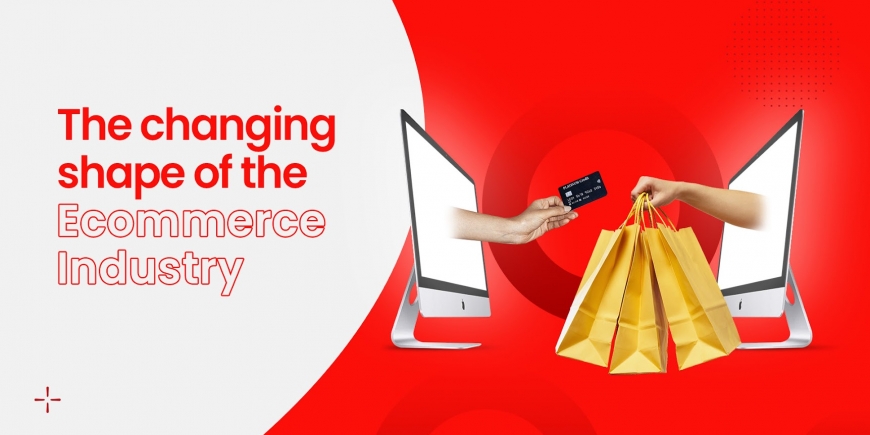The Changing Shape Of The E-commerce Industry
E-commerce is a major industry. So it’s no surprise that people are always wondering about the future of e-commerce.
Global e-commerce sales are expected to exceed $5.7 trillion by 2023, demonstrating that e-commerce is becoming a more profitable option for businesses.
That’s enormous, and the good news is that it’s not a new trend.
E-commerce is also a dynamic industry. Trends are constantly shifting in an attempt to shape the way people buy products all over the world.
This indicates optimism about the future of e-commerce.
Many significant changes are expected in the e-commerce market in the coming years. We’re here to help you understand how e-commerce will evolve in the future.
We’ll break down some of the top e-commerce trends for 2023, discuss what we believe will be the most significant changes over the next few years, and dissect why those changes may occur.
There’s a lot to cover, so let’s dive in.
Future of E-commerce for online retailers
1. New marketing channels will emerge
There have been advancements in several areas of e-commerce marketing in recent years, including a new mix of channels.
For example, with the release of Instagram and TikTok shopping features, brands `can run ads on social media platforms as well as enter the commerce space.
Furthermore, as an extension of social commerce, live shopping has begun to
gain traction globally. The live commerce market in China is expected to reach $4.92 billion by 2023. The concept is also gaining traction in the United States, with 20% of shoppers reporting having engaged in live commerce.
Connected TV advertising is another new channel that e-commerce companies are investigating. This entails running advertisements on platforms such as YouTube TV, Roku, and Hulu. Hoka, an athletic footwear brand, used this marketing strategy and reported a 68% increase in website visits as a result of its TV ad campaign.
2. The physical vs. online debate will heat up
We can’t discuss the future of e-commerce without addressing the ongoing physical versus online debate.
In this debate, most people in the e-commerce industry fall into one of two camps.
Some believe that it’s only a matter of time before physical stores are phased out in favor of an even larger shift toward online shopping. And some believe that physical shopping is entering a renaissance.
What is our stance? The growth of online shopping is undeniably outpacing that of brick-and-mortar stores.
But that doesn’t mean physical stores aren’t still extremely valuable assets for e-commerce companies.
Instead of serving as a physical representation of their online stores (which typically have access to a much larger inventory), brick-and-mortar locations appear to be shifting towards providing unique shopping experiences.
Consider Nike, which has already expanded into New York and Shanghai with its brand-new experiential shopping locations, or “Houses of Innovation.”
You can pick up exclusive products, customize products with your own hands, participate in fitness tests, try out products by playing fun games, enroll as a personal shopper, and more at Nike’s new physical stores.
These are experiences that cannot be obtained online, and they go a long way toward encouraging customer loyalty.
3. More consumers will use voice search
Voice-activated devices facilitated $40 billion in transactions in 2022. This represents a significant increase over the previous year’s figure of $2 billion for voice search transactions.
What is the most likely way for shoppers to use voice search? According to Narvar, 51% of shoppers use voice search to research products, while 36% use it to add relevant products to their shopping lists.
Consider optimizing your product information pages for common voice search commands in 2023 to become more voice-search-friendly. People may, for example, ask their voice assistant, “Where can I get apple products at a discount?”
4. Automation, automation, automation
Automation is set to play a significant role in the world of e-commerce.
Already, 61% of businesses worldwide use automation software and tools. More businesses are expected to invest in automation in the coming year as the benefits become clear.
Automation extends from marketing automation to warehousing and beyond for eCommerce businesses. It is an excellent option because it frees up employees’ time and resources for more important tasks.
For example, an e-commerce company with large warehouses can invest in robotics to become more efficient and free up staff to do more important tasks in the fulfillment process.
Automation software that can schedule inventory alerts for reordering when stock runs low can help supply chain management.
When it comes to e-commerce automation, the sky’s the limit. You can find software that will help your product with a little research.
5. Private labels to become more common
A private label product is one that is manufactured by one company but packaged and sold under the brand name of another. Companies rely on manufacturers to create products that are highly tailored to the needs of their target audience.
What is the significance of this e-commerce trend? If you work in a niche industry that relies on certain materials not being used or certain standards being met, you already know that private labeling is the best option for your company.
VegexPro, for example, offers private label products that are certified as Organic, HACCP, Kosher, Halal, RAW, Vegan, Gluten-Free, and Fair Trade. If your customers prefer vegan or gluten-free products, this is the manufacturer to work with.
Private labeling may be the next step for an online store that sells non-branded or drop shipped products.
6. Brands will lean into sustainability
As consumers become more vocal about climate change, more companies will be forced to develop sustainability initiatives. Climate-first stores experienced 5.8 times faster growth and saw their conversion rates increase by 20%, according to studies.
Although there are numerous ways to demonstrate sustainability, one simple method is to use sustainable packaging. Avery Dennison uses this strategy to ensure that its customers are satisfied with the way it conducts business.
Finding ways to be more sustainable will be a critical trend moving forward, whether it’s through eco-friendly packaging or using suppliers who prioritize the environment.
Future of E-commerce for marketers

7. Device usage will become even more important
When it comes to discussing the future of e-commerce, one thing is certain: the devices that buyers use when shopping online will be given much more weight.
But why is this so?
Historically, most e-commerce companies designed their shopping experiences to be desktop-first.
It’s now the other way around. E-commerce companies are determined to design and build their online stores with mobile commerce in mind.
And if you run your shop on Shopify, it will be relatively easy to please your audience.
You’ll have access to a plethora of themes designed to provide a seamless shopping experience regardless of the device your customers use.
Furthermore, you can easily test the adaptive version of your store’s design by resizing your browser—make it smaller on a desktop and you’ll see exactly what your mobile audience sees. This is one of the many advantages of using Shopify to run your business.
8. Personalization will be the key to success
E-commerce companies are constantly improving their customers’ shopping experiences.
Algorithms are now in place to track shopper activity, allowing businesses to consistently optimize their advertising campaigns. They are constantly working to show you the products that they believe you will buy.
However, we may have reached a tipping point.
People seem to be getting tired of knowing that algorithms are messaging them rather than real people and are now craving personalization in their shopping experiences across the web.
Buyers want to believe that there is someone caring about them behind the computer screen. It doesn’t have to be anything complicated either—it could be as simple as a personalized email, a carefully curated discount code, or something else.
According to research, 76% of consumers said that receiving personalized communications was an important factor in making them consider a brand.
So, what does all of this mean?
Businesses and entrepreneurs will need to find ways to build direct relationships with their customers as part of e-commerce.
9. Customer experience will be prioritized
Customer experiences, both pre-and post-purchase, are critical to the success of your online business. Hiring incredible in-house sales assistants who can guide your customers through the sales process can alleviate any stress your customers may feel.
Online sales process analysis to learn what a customer would expect is critical for your e-commerce store. This could imply testing your sales channels or checkout flows with real people to identify potential customer pain points.
Among the things you can test on your website are:
- Your call to action
- The length of your checkout process
- The information asked for on the checkout page
- Your messaging
- Your product page flow
This activity should improve the customer experience at your company. This discipline has recently grown in popularity, making it a major e-commerce trend for 2023.
10. AI and chatbots will become personal assistants
Following on from our previous e-commerce trend, the use of AI and chatbots to assist customers in achieving their goals while on your site.
Chatbots have been around for a few years and are constantly evolving to help customers on social media and elsewhere. This is ideal for businesses that operate in multiple countries but lack the resources to be online and assist customers 24 hours a day, seven days a week.
AI assistants are also very important for online stores because they can manage stock levels, reordering, and other processes that can free up your day to do things you wouldn’t normally have time for.
AI and chatbots have exploded in popularity in recent years, but technological advances indicate that this trend will continue.
With each passing year, AI is being applied to a new discipline or department within a company. Check out some of these AI apps that can help your business today if you have a Shopify store.
11. Interactive products will be a thing
One of the most significant disadvantages of e-commerce is that customers cannot try out the product before purchasing it, as they would in a physical store. People are more satisfied when they can touch, feel, and try an item before purchasing it, according to typical consumer behavior.
This experience is nearly lost on e-commerce websites, but technology is always one step ahead. Using augmented reality technology, you can create immersive shopping experiences in which customers can interact with products before purchasing them.
For example, Shopify AR allows brands to show customers their products in natural environments before buying them to ensure that the product fits the intended purpose. When it comes to choosing a brand to buy from, this allows customers to make great decisions quickly.
AR and VR interactive products are a new trend, but they are quickly being adopted by e-commerce brands to assist customers in selecting the right product. If you’re not sure which e-commerce trend to join, this is a good place to start.
Closing thoughts on the future of e-commerce
E-future commerce will undoubtedly be full of exciting changes and innovations
for both businesses and consumers.
Whether you’re an entrepreneur or work for an e-commerce company, it’s critical to stay up to date on changes in the e-commerce landscape.
The best advice we can give is to keep learning.
Read articles. View videos. Listen to podcasts.
Consume as much information about the field of e-commerce as possible—this will give you an advantage over your competitors.
Follow us for more e-commerce-related articles!
850 total views
There are no comments



